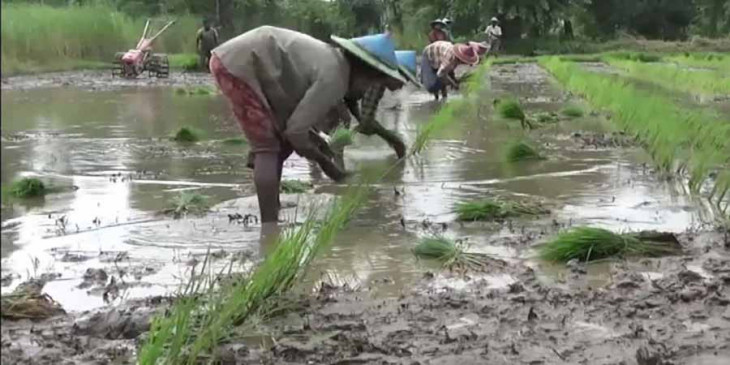Min Aung Hlaing’s target for edible oil and rice production may not be met and is designed to benefit specific groups rather than farmers, an agricultural expert claimed.
The junta leader is expecting a sufficient amount of oil crops to be produced during the second growing season in 2023 and hopes to grow around 90 million bushels of rice– if one acre is able to produce more than five bushels of rice. He made the predictions at a management committee meeting of the State Administration Council (SAC) held on Aug. 8.
He said that palm oil production in Burma is low, as the country only has 400,000 acres of palm oil plantations, low in comparison to neighboring countries. Currently, the junta-appointed Investment Commission is calling for investments in agricultural business – including contract farming, production of oilseeds, the manufacture of various oils and oil milling.
In order to boost the oil crop industry, the SAC formed the Oil Crops Expansion Agriculture Committee and plans to plant 1.5 million acres of sunflowers in the 2022-2023 fiscal year nationwide.
Min Aung Hlaing says he expects Burma to produce a sufficient amount of edible oil after the second season of oil crop harvests in 2023 if oilseed crops are grown efficiently.
“We have groups and associations like the Myanmar Rice Federation. Imagine if those federations bought rice from the farmers at a cheap price. Only the merchants are getting rich from crops whether it is rice or beans, but not farmers,” a researcher told DVB regarding Min Aung Hlaing’s project. “These procedures are based on faulty policies. This will only favor certain groups or associations, but not farmers. This policy will not succeed if it is not for farmers.”
The demand for edible oil in Burma is around 1.3 million tons per year. However, only 400,000 tons are locally produced, thus requiring 800,000 to 1 million tons to be imported every year. This amount is worth over US $800 million.
The SAC is planning to expand local oil crop plantations in order to reduce the need for foreign currency, but is conversely hoping to increase rice harvests to an average of five bushels per acre in order to earn foreign currency.
Of the 15 million acres of rainfed rice and 3 million acres of spring rice in Burma, one acre of rainfed rice produces about 75 bushels and one acre of spring rice produces about 90 bushels. However, the military chief said there is no surplus of exported rice for local use when it is weighed seasonally.
“If the land is good, then production will be good, but the Ministry of Agriculture needs to make policies depending on whether the production is bad and work to improve it. The Japanese government seems to be doing this. The final products need to be sold by the government. For example, China or India have blocked [rice] purchases [from Burma] when they are unsatisfied with the quality. The government should make policies to ensure this does not happen,” the researcher said.
According to the data released by the Myanmar Rice Federation, the monthly export of rice and broken rice was 250,000 metric tons in April, 153,000 in May, 146,000 in June and 182,000 in July, earning US $82 million in April, US $51 million in May, US $50 million in June and US $66 million in July.
However, farmers have been forced to flee their lands due to political instability as well as the military’s offensives in Burma’s agricultural heartlands, heavily impacting rice production in the coming year.
The UNDP warned that half of Burma’s 55 million people are at risk of poverty at the beginning of this year.



